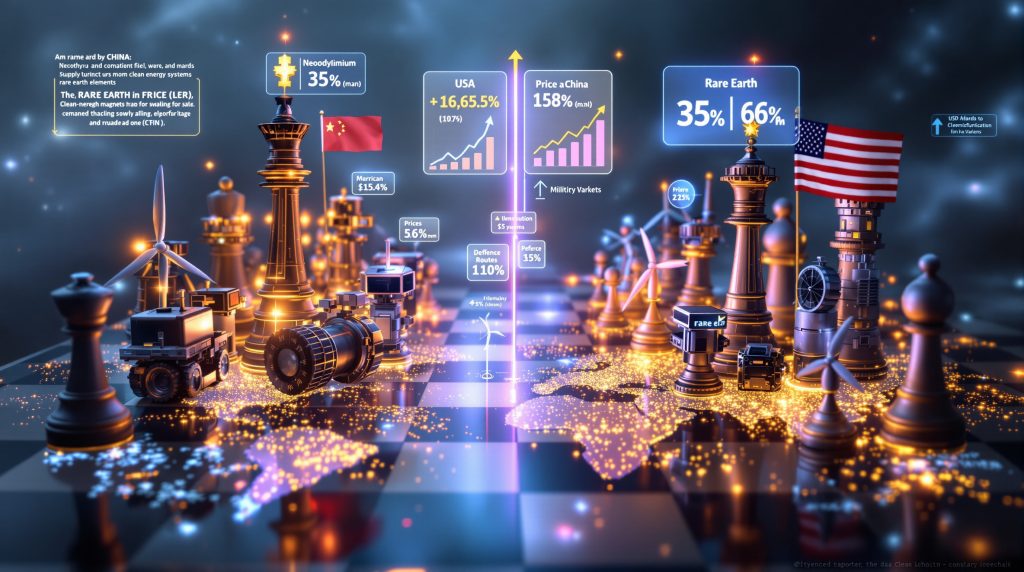How Have Rare Earth Elements Become a Geopolitical Flashpoint?
Rare earth elements (REEs) have evolved from obscure industrial materials to critical components in modern technology and defense systems. Despite their name, these 17 elements are relatively abundant in Earth's crust, but economically viable concentrations are geographically limited. The strategic significance of these materials has created a complex web of rare earth reserves distribution between the United States and China, with profound implications for national security, economic competitiveness, and technological advancement.
Understanding the US-China rare earth supply dependencies requires looking beyond simple mining statistics to examine the entire production process—from extraction to processing and manufacturing of end-use components. This interconnected system has become a central concern in global economic security discussions.
The Strategic Value of Rare Earth Elements
Rare earth elements serve as essential ingredients in technologies that define modern economies:
- Defense Applications: Precision-guided missiles, radar systems, night vision equipment, and communications technology
- Clean Energy Technologies: Wind turbines, electric vehicle motors, and battery storage systems
- Consumer Electronics: Smartphones, computers, speakers, and display screens
- Medical Equipment: MRI machines, surgical tools, and diagnostic devices
- Advanced Manufacturing: Lasers, robotics, and precision instruments
The unique magnetic, luminescent, and electrochemical properties of these elements make them virtually irreplaceable in many applications, creating strategic vulnerabilities for nations without secure supply chains. For example, neodymium-iron-boron (NdFeB) magnets, which contain neodymium, praseodymium, dysprosium, and other rare earths, are the strongest permanent magnets commercially available—up to ten times stronger than conventional ferrite magnets.
What Drives China's Dominance in the Rare Earth Market?
China's commanding position in the global rare earth supply chain represents decades of strategic planning and investment. This dominance extends beyond mining operations to encompass the entire value chain, creating significant dependencies for Western economies.
The country's approach has been methodical and long-term, focusing not just on extraction but on building expertise in processing, separation, and manufacturing of value-added products. This comprehensive defence‐critical strategy has given China unparalleled influence over global supply chains.
The Evolution of China's Rare Earth Strategy
China's rare earth dominance wasn't accidental but developed through deliberate policy choices:
| Timeline | Strategic Development |
|---|---|
| 1980s | Initial focus on mining domestic rare earth deposits |
| 1990s | Development of processing capabilities and technical expertise |
| 2000s | Consolidation of industry under state-controlled entities |
| 2010s | Implementation of export quotas and strategic restrictions |
| 2020s | Administrative controls and expansion into global supply chains |
Chinese leader Deng Xiaoping famously recognized the strategic value of these resources early on, stating in a speech that while "the Middle East has oil, China has rare earths." This early recognition of rare earths as strategic assets rather than mere commodities guided decades of industrial policy.
China's Control Across the Value Chain
China's dominance spans the entire rare earth production process:
- Mining Operations: Controls approximately 58% of global production capacity
- Processing Technology: Holds 87% of separation and refining capacity
- Manufacturing Integration: Dominates magnet production with 92% market share
- Pricing Mechanisms: Influences global markets through production quotas
- Technical Expertise: Maintains the world's largest pool of rare earth specialists
This comprehensive control creates multiple dependency points for international supply chains, particularly for high-purity separated oxides required in advanced applications. The most significant advantage lies not in mining but in the mid-stream processing capabilities—the technically complex steps that convert raw materials into usable industrial inputs.
How Vulnerable is the US Rare Earth Supply Chain?
The United States faces significant vulnerabilities in its rare earth supply chain, with dependencies that extend from raw materials to finished components. These vulnerabilities create both economic and national security risks.
The reopening of the Mountain Pass mine in California provided domestic access to raw materials, but processing dependencies remain a critical weakness in the supply chain. This imbalance has prompted increased focus on rebuilding domestic processing capabilities.
Quantifying US Dependency on Chinese Rare Earths
Recent data reveals the extent of US reliance on Chinese rare earth supplies:
- Import Dependency: The US sources approximately 78% of its rare earth compounds and metals directly from China
- Processing Gap: Over 90% of rare earth separation occurs in Chinese facilities
- Defense Supply Chain: Approximately 87% of rare earth materials in US defense systems originate from Chinese-controlled supply chains
- Domestic Production: The US produces only about 15% of the rare earths it consumes
- Magnet Manufacturing: Less than 2% of rare earth permanent magnets are produced domestically
The rare earth supply chain represents one of the most significant vulnerabilities in US manufacturing and defense industrial bases. Without intervention, this dependency will persist for at least the next decade.
This dependency creates fundamental challenges for US industrial policy, especially as demand for rare earth materials in clean energy technologies is projected to increase by 300-500% over the next two decades, according to industry forecasts.
Critical Vulnerabilities in the Defense Sector
The defense sector faces particular challenges due to rare earth dependencies:
- Missile Guidance Systems: Require neodymium, praseodymium, and samarium
- Radar Technology: Depends on gadolinium, terbium, and dysprosium
- Communications Equipment: Utilizes yttrium, lanthanum, and cerium
- Night Vision Systems: Rely on europium, yttrium, and erbium
- Aircraft Components: Incorporate multiple rare earth elements in engines and electronics
These dependencies create potential points of leverage in geopolitical conflicts, raising concerns about supply disruptions during periods of international tension. For example, an F-35 fighter jet contains approximately 920 pounds of rare earth materials across various components, illustrating the depth of military dependency on these elements.
What Administrative Controls Has China Implemented?
China has moved beyond explicit export restrictions to implement sophisticated administrative controls that maintain market dominance while avoiding direct confrontation with trading partners.
These measures represent a more nuanced approach than previous quota systems that triggered international trade disputes. The current framework focuses on oversight and compliance rather than outright bans, creating a more defensible regulatory position.
The Evolution of China's Regulatory Approach
China's approach to controlling rare earth exports has become increasingly sophisticated:
- Early Quotas (2010-2014): Direct export restrictions that faced WTO challenges
- Environmental Regulations (2014-2018): Production limits justified on environmental grounds
- Industry Consolidation (2018-2022): Mergers creating state-controlled enterprises
- Administrative Oversight (2022-Present): Reporting requirements and compliance mechanisms
The current approach focuses on administrative measures rather than explicit bans, creating compliance burdens that effectively limit exports while maintaining plausible deniability about trade restrictions. These mechanisms avoid direct confrontation with trading partners while achieving similar supply management objectives.
Monthly Reporting and Traceability Requirements
Recent administrative controls include sophisticated tracking mechanisms:
- Monthly Production Reporting: Mandatory submission of detailed production data by the 10th of each month
- Material Traceability Systems: Requirements to document the origin and destination of all rare earth materials
- Imported Feedstock Quotas: Limits on processing foreign rare earth concentrates
- Preferential Licensing: Expedited approvals for domestic supply chains
- Compliance Audits: Regular inspections of processing facilities and export documentation
These measures create systematic constraints on international supply chains while providing Chinese authorities with real-time visibility into material flows. They represent a more sophisticated approach than previous export quotas, focusing on regulatory compliance rather than direct market intervention.
How Are Rare Earth Prices Responding to Supply Chain Pressures?
Rare earth pricing reflects the complex interplay of supply constraints, demand growth, and geopolitical tensions. Recent price trends reveal growing premiums for non-Chinese materials and increasing volatility in global markets.
This bifurcated pricing structure reflects the structural scarcity of non-Chinese material and the growing willingness of buyers to pay premiums for supply chain security. The price differential creates economic incentives for developing alternative sources while supporting the economics of new projects.
The Growing China vs. Non-China Price Differential
Price data shows significant and persistent premiums for rare earth materials produced outside China:
| Element | Chinese Price (USD/kg) | Non-Chinese Price (USD/kg) | Premium (%) |
|---|---|---|---|
| Neodymium | $87 | $132 | 52% |
| Praseodymium | $93 | $147 | 58% |
| Dysprosium | $312 | $487 | 56% |
| Terbium | $1,210 | $1,875 | 55% |
| Samarium | $14 | $23 | 64% |
These price differentials reflect both the structural scarcity of non-Chinese materials and the growing willingness of buyers to pay premiums for supply chain security. Industry analysts point to this sustained price gap as evidence of a fundamental shift in market structure rather than a temporary phenomenon.
Price Floor Mechanisms and Market Stabilization
Government interventions are creating price floor mechanisms that reduce investment risk:
- US Department of Defense Guarantees: $110/kg floor price for domestically produced NdPr
- EU Critical Raw Materials Act: Funding mechanisms that effectively guarantee minimum returns
- Japanese Strategic Stockpile Program: Purchasing commitments at predetermined price levels
- Australian Critical Minerals Facility: Financing that incorporates price support mechanisms
- South Korean Battery Materials Fund: Investments with embedded price guarantees
These mechanisms reduce downside risk for new projects while maintaining incentives for supply chain diversification. The price floor approach provides security for project developers while avoiding market distortions associated with direct subsidies.
What US Policy Initiatives Address Rare Earth Dependencies?
The United States has implemented multiple policy initiatives aimed at reducing rare earth dependencies and rebuilding domestic supply chains. These efforts span defense procurement, industrial policy, and international partnerships.
These programs represent a fundamental shift in US industrial policy, moving from market-based approaches toward more direct government involvement in critical minerals reserve development. This transition reflects growing recognition of the national security implications of material dependencies.
Defense Production Act and Military Procurement
Defense-focused initiatives provide immediate support for supply chain diversification:
- Title III Defense Production Act: Funding for domestic rare earth processing facilities
- Defense Logistics Agency Stockpiling: Strategic reserves of critical rare earth materials
- Military Specification Requirements: Mandates for domestically-sourced components
- CHIPS and Science Act Provisions: Support for semiconductor supply chains including rare earth inputs
- Defense Innovation Unit Programs: Technology development for rare earth alternatives
These programs create near-term market opportunities for non-Chinese suppliers while supporting longer-term capacity development. The Defense Production Act authorizes direct funding for critical materials projects, with rare earth processing facilities receiving priority designation.
International Partnerships and Supply Chain Resilience
Bilateral and multilateral initiatives expand beyond domestic capacity:
- Quad Critical Minerals Partnership: Collaboration between US, Japan, Australia, and India
- US-EU Trade and Technology Council: Coordination on supply chain security
- US-Canada Critical Minerals Action Plan: Integration of North American resources
- Australia-US Critical Minerals Acceleration: Joint development of processing capabilities
- Japan-US Economic Policy Consultative Committee: Rare earth supply chain coordination
These partnerships create diversified supply networks that reduce vulnerability to disruption from any single source. The multilateral approach recognizes that comprehensive supply chain resilience requires international coordination rather than purely domestic solutions.
Which Companies Are Positioned to Reduce Western Dependencies?
Several companies are developing capabilities to address Western rare earth dependencies through mining, processing, recycling, and separation technologies. These firms represent potential investment opportunities while contributing to supply chain resilience.
Industry participants range from established producers to technology-focused startups developing innovative processing methods. The most promising opportunities combine technical innovation with strategic positioning along key supply chain bottlenecks.
Separation and Processing Platforms
Companies developing rare earth separation capabilities outside China include:
- Lynas Rare Earths: Australia-based producer with processing facilities in Malaysia and planned US operations
- MP Materials: Operating the Mountain Pass mine in California with developing separation capabilities
- Ucore Rare Metals: Developing RapidSX™ separation technology for a Louisiana processing facility
- Pensana: Constructing an integrated rare earth processing facility in the UK
- Neo Performance Materials: Operating the only commercial rare earth separation facility in Europe
These companies focus on the critical midstream processing capabilities that represent the most significant supply chain bottleneck. Their technologies address the complex separation challenges that have historically concentrated in Chinese facilities.
Recycling and Alternative Sourcing Strategies
Innovative approaches to rare earth recovery provide near-term supply alternatives:
- Ionic Rare Earths: Developing recycling technology for end-of-life magnets and electronic waste
- Urban Mining Company: Producing recycled rare earth magnets from recovered materials
- REEtec: Implementing energy-efficient separation technology for recycled and primary materials
- Geomega Resources: Developing magnet recycling technology with reduced environmental impact
- Mkango Resources: Integrating mining and recycling operations for comprehensive supply
Recycling technologies offer accelerated timelines compared to traditional mining projects, with first production possible within 12-24 months of funding. This faster path to market creates advantages in responding to near-term supply constraints while avoiding the permitting and development challenges associated with new mining operations.
How Do Heavy Rare Earth Elements Present Special Challenges?
Heavy rare earth elements (HREEs) present unique supply challenges due to their scarcity, processing complexity, and critical applications. These elements face particularly severe supply constraints outside China.
The supply limitations for heavy rare earths are more pronounced than for light rare earths, creating particular vulnerabilities for technologies that require these specialized materials. This scarcity drives premium pricing and strategic concern among defense and technology sector planners.
The Strategic Significance of Heavy Rare Earths
Heavy rare earths serve essential functions in advanced technologies:
- Dysprosium: Critical for high-temperature performance in permanent magnets
- Terbium: Essential for magnetostrictive alloys and phosphors
- Yttrium: Key component in laser technologies and ceramic materials
- Europium: Required for advanced display technologies and nuclear applications
- Holmium: Used in specialized magnets and nuclear control rods
These elements typically represent a small percentage of rare earth deposits but account for a disproportionate share of value and strategic importance. For instance, dysprosium and terbium are essential for maintaining magnetic performance at high temperatures, making them irreplaceable in certain defense and energy transition security applications.
Limited Non-Chinese HREE Sources
Heavy rare earth supply remains particularly concentrated:
- Ion-Adsorption Clay Deposits: Primarily located in southern China and Myanmar
- Xenotime Mineralogy: Limited occurrences in Australia, Brazil, and Malaysia
- Recycling Recovery: Complex separation challenges from end-of-life products
- By-Product Recovery: Limited potential from uranium and phosphate processing
- Deep-Sea Resources: Experimental recovery from Pacific Ocean nodules
The scarcity of economically viable heavy rare earth sources outside China creates persistent supply vulnerabilities for technologies requiring these elements. Ion-adsorption clay deposits, which provide the majority of heavy rare earths, are geologically rare outside southern China and parts of Southeast Asia, limiting geographic diversification options.
What Investment Frameworks Apply to Rare Earth Supply Chains?
Investment in rare earth supply chains requires specialized analytical frameworks that account for geopolitical risks, policy support mechanisms, and unique market dynamics. These frameworks help identify opportunities while managing the specific challenges of this strategic sector.
Traditional commodity investment approaches require significant modification to capture the unique value drivers in the rare earth sector. The strategic nature of these materials creates both risks and opportunities that aren't adequately captured by conventional analytical methods.
Risk-Adjusted Valuation Models
Traditional valuation models require modification for rare earth investments:
- Geopolitical Risk Premiums: Adjustments for supply chain vulnerability and policy intervention
- Policy Support Valuation: Incorporation of government incentives and price guarantees
- Dual Pricing Scenarios: Modeling both Chinese and non-Chinese market dynamics
- Strategic Premium Calculation: Quantifying the value of supply chain security
- Milestone-Based Valuation: Progressive de-risking based on technical achievements
These modifications help capture the unique value drivers in rare earth markets that extend beyond traditional commodity pricing. The strategic premium concept recognizes that secure supply chains command value beyond pure market pricing, particularly for materials used in defense applications or critical infrastructure.
Portfolio Construction and Diversification Strategies
Effective rare earth investment strategies incorporate multiple exposure types:
- Midstream Processing Focus: Emphasizing separation and oxide production capabilities
- Technology Differentiation: Prioritizing proprietary processing methods with efficiency advantages
- Heavy Rare Earth Exposure: Allocating to projects with significant HREE content
- Recycling Integration: Including circular economy approaches alongside primary production
- Geographic Diversification: Spreading exposure across multiple jurisdictions and regulatory environments
This diversified approach helps manage the specific risks associated with rare earth supply chains while capturing opportunities across the value chain. Midstream processing represents the critical bottleneck in global supply chains, offering potentially higher returns than pure mining operations.
What Future Scenarios Might Reshape Rare Earth Dependencies?
The future of US-China rare earth dependencies will be shaped by technological innovation, policy evolution, and market restructuring. Several potential scenarios could significantly alter current supply chain dynamics.
While complete decoupling appears unlikely given the complex interdependencies, various pathways toward reduced vulnerability and increased resilience are emerging. These scenarios represent different evolutionary paths rather than abrupt transitions.
Technological Disruption Scenarios
Innovation could fundamentally reshape rare earth dependencies:
- Substitute Material Development: New magnet compositions that reduce or eliminate critical rare earths
- Recycling Efficiency Breakthroughs: Technologies enabling near-complete recovery from end-of-life products
- Additive Manufacturing Advances: Reduced material requirements through precision manufacturing
- Alternative Energy Storage: Technologies that bypass rare earth requirements in renewable energy
- Quantum Computing Materials: New material systems for next-generation computing
These technological shifts could reduce dependency on traditional rare earth supply chains while creating new strategic materials requirements. Research initiatives focusing on reduced dysprosium content in permanent magnets have already demonstrated potential for decreasing heavy rare earth requirements in certain applications.
Policy and Market Evolution Pathways
Structural changes in markets and policy could transform dependency relationships:
- Circular Economy Mandates: Requirements for recycled content in new products
- Supply Chain Transparency Regulations: Mandatory disclosure of material origins
- Strategic Reserve Systems: Government-managed buffer stocks to reduce market volatility
- Bilateral Processing Agreements: Joint ventures between consuming and producing nations
- Market-Based Certification Systems: Premium pricing for verified non-Chinese supply chains
These evolutionary pathways suggest a future of more diverse, transparent, and resilient supply chains rather than simple decoupling or continued dependency. Policy frameworks increasingly recognize the need for structural market interventions to address strategic vulnerabilities that pure market mechanisms haven't resolved.
Conclusion: Navigating the Rare Earth Dependency Challenge
The US-China rare earth relationship reflects broader supply chain interdependencies that constrain extreme policy measures while creating persistent structural premiums for diversified supply. This environment rewards strategic positioning across the value chain while requiring sophisticated risk management approaches.
Successful navigation of rare earth dependencies requires integrated strategies that combine technological innovation, policy engagement, and market development. Companies that effectively address these challenges will capture significant value while contributing to broader economic resilience and national security objectives.
The rare earth sector demonstrates how critical mineral supply chains have evolved from purely economic considerations to fundamental components of geopolitical strategy. This evolution creates both risks and opportunities for investors, policymakers, and corporate leaders seeking to build resilient industrial ecosystems in an increasingly complex global environment.
While complete supply chain independence appears neither feasible nor economically rational, targeted diversification strategies can address the most critical vulnerabilities while leveraging existing capabilities. The resulting framework balances security concerns with economic realities, creating a more resilient system that maintains the benefits of specialization while reducing extreme dependency risks.
In the long term, the development of the European CRM facility may provide an additional avenue for reducing US-China rare earth supply dependencies by creating alternative processing capacity within a trusted allied nation.
Want to Catch the Next Major Mineral Discovery?
Discovery Alert's proprietary Discovery IQ model instantly notifies investors about significant ASX mineral discoveries like rare earths, transforming complex data into actionable insights with proven results. Explore how historic discoveries have generated substantial returns by visiting Discovery Alert's dedicated discoveries page and begin your 30-day free trial to position yourself ahead of the market.




